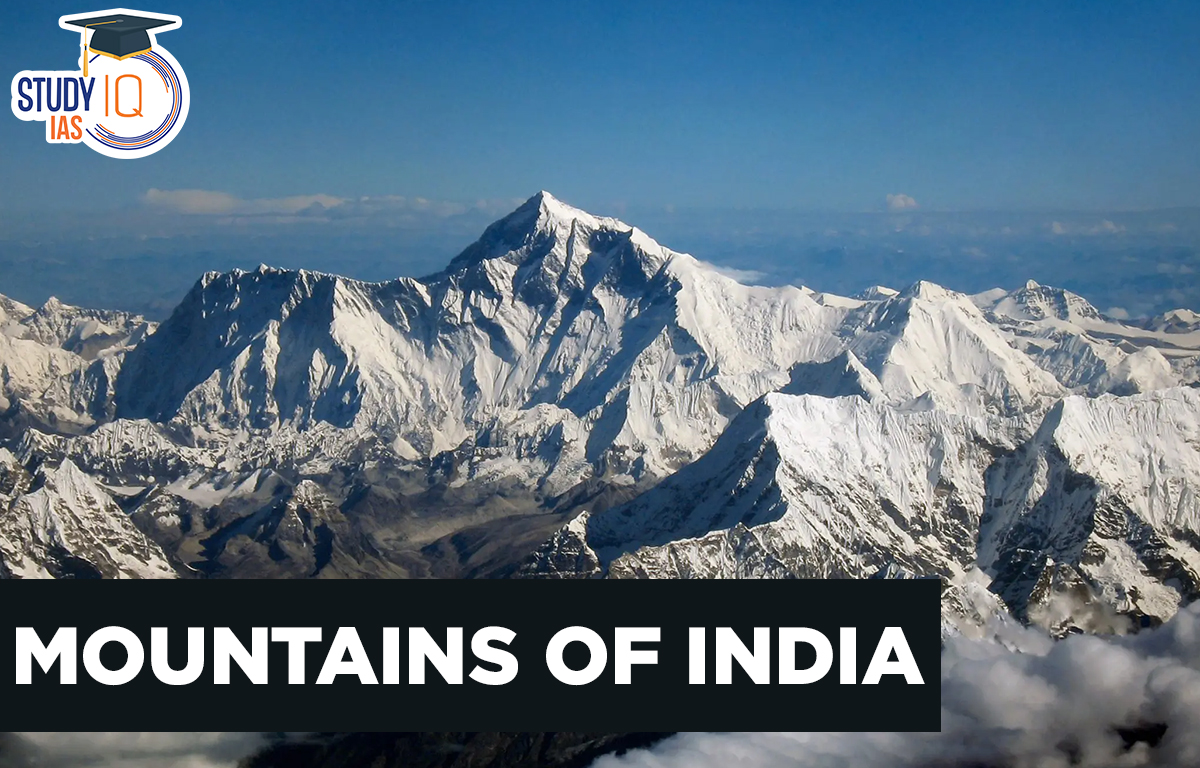Table of Contents
India’s mountains play a very important role in shaping the country’s environment. Tourists are attracted to these beautiful mountains, known as the abodes of the Gods, for their clean air, religious significance, and thrilling adventure sports. They offer a refreshing air from the intense heat that covers most of India between April and May.
India is home to some of the world’s tallest and most majestic mountain ranges, with stunning landscapes and diverse ecosystems. The altitudes and ranges support a wide variety of plants and wildlife. At the base of the Himalayan Mountain Ranges, you can find tropical and subtropical forests.
The snow-covered mountains in Himachal Pradesh and Kashmir are amazing to see. Mountain ranges like the Nilgiri, Shivalik, Vindhya, Satpura, Western Ghats, Himalaya, Aravalli, and Eastern Ghats keep the environment beautiful and balanced. These mountains are popular tourist spots with thick forests full of different plants and animals.
List of Mountains in India
India boasts a varied collection of mountains that stretch across its extensive geography, presenting natural splendor and environmental value. The most significant mountain chain is the Himalayas, which features some of the highest peaks in the world, such as Kangchenjunga (8,586 m), the tallest mountain in India. Other notable ranges are the Western Ghats, Eastern Ghats, Aravalli Range, Vindhya Range, and Satpura Range. There are many individual peaks within each range, including Anamudi in Kerala (Western Ghats), Gurushikhar in Rajasthan (Aravallis), and Mahendragiri in Odisha (Eastern Ghats). These mountains impact not only India’s climate and water regimes but also harbor rich biodiversity and hold a sacred place in Indian culture and spirituality. Read this article to get the List of Mountains in India along with some other important information.
Highest Mountain Ranges in India
1. Kangchenjunga Peak
India’s highest mountain peak is called Kanchenjunga. The mountain is the third-tallest in the world. It is tall, has a height of 8,586 metres (28,169 ft). Kanchenjunga’s name translates to “The Five Treasures of Snows” (namely gold, silver, gems, grain, and holy books). Positioned on the line separating India and Nepal.
2. Nanda Devi Peak
Nanda Devi is the second-highest mountain peak in India. It has the highest elevation in Uttarakhand, located in the Garhwal Himalayas. Nanda Devi is the 23rd-highest peak in the world. Before 1808, Nanda Devi was thought to be the highest mountain in the world until it was found that Dhaulagiri is higher. It was also the highest mountain in India until 1975, when Sikkim became a part of India. Nanda Devi is located in the Chamoli district of Uttarakhand, between the Rishiganga valley to the west and the Goriganga valley to the east.
3. Kamet Peak
Kamet Peak is the third-highest peak in India. It is the highest peak in the Zaskar Mountain Range in Uttarakhand’s Chamoli District. After Nanda Devi, Kamet is the second-tallest peak in the Garhwal region of Uttarakhand. From a distance, it looks like a giant pyramid with a flat top and two peaks. Kamet is surrounded by the Paschim Kamet glacier to the west, the Purbi Kamet glacier to the east, and the Raikana glacier system.
4. Saltoro Kangri Peak
Saltoro Kangri Peak is the fourth-highest peak in India. It is the tallest mountain in the Saltoro Mountain Range, which is part of the Karakoram subrange in the greater Himalayan Mountains. The Siachen Glacier, one of the world’s longest glaciers, is located in Saltoro. Saltoro Kangri is the 31st-highest independent mountain peak in the world.
5. Saser Kangri Peak
Saser Kangri is the 35th-highest mountain in the world and the fifth-highest peak in India. It is part of the Saser Muztagh range in Jammu and Kashmir and consists of five impressive summits. Saser Kangri is also a subrange of the Karakoram Range, located on its southeastern side.
6. Mamostong Kangri Peak
Mamostong Kangri is the 48th highest peak in the world and the sixth highest peak in India. It is the tallest peak in the Rimo Mustagh subrange of the Great Karakoram Mountains. It lies close to the Siachen Glacier and stands at a lofty height of 7,516 m (24,659 ft).
7. Rimo Peak
The Rimo, which graces the northern side of Rimo Muztagh, is again a part of the great Karakoram ranges. The Rimo mountain series comprises four peaks, with Rimo I being the highest among them. To the northeast of the Rimo Mountains is the Karakoram Pass, one of the vital trade routes in central Asia. Rimo forms a part of the Siachen Glacier and holds a staggering elevation of 7,385 m (24,229 ft).
8. Hardeol Peak
Hardeol Peak comes in seventh. Hardeol, also called the Temple of God, is a famous peak in the Kumaon Himalayas. It is located in the northern part of the Kumaon Sanctuary, near Nanda Devi. You can find Hardeol in the Milam valley, which is in the Pithoragarh district of Uttarakhand.
9. Chaukamba Peak
Chaukhamba Peak is ranked ninth on the list. It is the tallest peak in the Gangotri group, located in Uttarakhand’s Garhwal Himalaya. The Gangotri Group consists of four peaks, with Chaukhamba being the highest. The name comes from the close arrangement of these four peaks.
10. Trisul Peak
Trisul is one of three mountain peaks in a group, and it ranks tenth on the list. It is located in the hilly Kumaon region of Uttarakhand. The tallest peak, Trisul, is 7120 meters high. The name comes from Lord Shiva’s Trishul (trident). This group of peaks is near the Nanda Devi sanctuary.
List of Mountains in India From North to South
Here is the List of All Mountains in India with their Names:
| List of Mountains | Height (m) | Range | State |
| Kanchenjunga | 8,586 | Himalayas | Sikkim |
| Nanda Devi | 7,816 | Garhwal Himalaya | Uttarakhand |
| Kamet | 7,756 | Garhwal Himalaya | Uttarakhand |
| Saltoro Kangri / K10 | 7,742 | Saltoro Karakoram | Ladakh |
| Saser Kangri I / K22 | 7,672 | Saser Karakoram | Ladakh |
| Mamostong Kangri / K35 | 7,516 | Rimo Karakoram | Ladakh |
| Saser Kangri II E | 7,513 | Saser Karakoram | Ladakh |
| Saser Kangri III | 7,495 | Saser Karakoram | Ladakh |
| Teram Kangri I | 7,462 | Siachen Karakoram | Ladakh |
| Jongsong Peak | 7,462 | Kangchenjunga Himalaya | Sikkim |
| K12 | 7,428 | Saltoro Karakoram | Ladakh |
| Kabru N | 7,412 | Kangchenjunga Himalaya | Sikkim |
| Ghent Kangri | 7,401 | Saltoro Karakoram | Ladakh |
| Rimo I | 7,385 | Rimo Karakoram | Ladakh |
| Teram Kangri III | 7,382 | Siachen Karakoram | Ladakh |
| Kirat Chuli | 7,362 | Kangchenjunga Himalaya | Sikkim |
| Mana Peak | 7,272 | Garhwal Himalaya | Uttarakhand |
| Apsarasas Kangri | 7,245 | Siachen Karakoram | Ladakh |
| Mukut Parbat | 7,242 | Garhwal Himalaya | Uttarakhand |
| Rimo III | 7,233 | Rimo Karakoram | Ladakh |
| Singhi Kangri | 7,202 | Siachen Karakoram | Ladakh |
| Hardeol | 7,161 | Kumaon Himalaya | Uttarakhand |
| Chaukhamba I / Badrinath Peak | 7,138 | Garhwal Himalaya | Uttarakhand |
| Nun-Kun | 7,135 | Zanskar Himalaya | Ladakh |
| Pauhunri | 7,128 | Sikkim Himalaya | Sikkim |
| Pathibhara / The Pyramid | 7,123 | Kangchenjunga Himalaya | Sikkim |
| Trisul I | 7,120 | Kumaon Himalaya | Uttarakhand |
| Satopanth | 7,075[1] | Garhwal Himalaya | Uttarakhand |
| Tirsuli | 7,074 | Garhwal Himalaya | Uttarakhand |
| Chong Kumdang Ri | 7,071[2] | Rimo Karakoram | Ladakh |
| Dunagiri | 7,066 | Garhwal Himalaya | Uttarakhand |
| Kangto | 7,060 | Assam Himalaya | Arunachal Pradesh |
| Nyegyi Kansang | 7,047 | Assam Himalaya | Arunachal Pradesh |
| Padmanabh | 7,030[2] | Rimo Karakoram | Ladakh |
| Shudu Tsempa | 7,024[4] | Sikkim Himalaya | Sikkim |
| Chamshen Kangri / Tughmo Zarpo | 7,017[5] | Saser Karakoram | Ladakh |
| Aq Tash | 7,016[6] | Rimo Karakoram | Ladakh |
| Chong Kumdang Ri II | 7,004[2] | Rimo Karakoram | Ladakh |
| Rishi Pahar | 6,992 | Kumaon Himalaya | Uttarakhand |
| Thalay Sagar | 6,984 | Garhwal Himalaya | Uttarakhand |
| Mount Lakshmi | 6,983 | Rimo Karakoram | Ladakh |
| Kedarnath Main | 6,968 | Garhwal Himalaya | Uttarakhand |
| Langpo | 6,965[7] | Sikkim Himalaya | Sikkim |
| Saraswati Parvat I / Saraswati Peak | 6,940[1] | Garhwal Himalaya | Uttarakhand |
| Shahi Kangri | 6,934[8] | Central Tibetan Plateau | Ladakh |
| Sri Kailash | 6,932 | Garhwal Himalaya | Uttarakhand |
| Kalanka | 6,931 | Garhwal Himalaya | Uttarakhand |
| Chorten Nyima Ri | 6,927[7] | Sikkim Himalaya | Sikkim |
| Saf Minal / P. 6911 | 6,911[9] | Garhwal Himalaya | Uttarakhand |
| Panchchuli II | 6,904[10] | Kumaon Himalaya | Uttarakhand |
List of Highest Mountain Peaks in India
Check the full List of Highest Mountain Peaks in India:
| Mountain Peak | Height | Description |
| K2 | 8611 metres | It is the tallest peak in the Karakoram Range and is located between Baltistan and Xinjiang on the Indian subcontinent. |
| Kangchenjunga | 8586 metres | The Himalayan Mountain Range is home to the third-highest summit in the world, also referred to as the “five gems of snow.” |
| Nanda Devi | 7816 metres | The Nanda Devi National Park, which lies close to the mountain and contains the best high altitude flora and fauna, is ranked as the world’s 23rd highest peak. This mountain is the tallest peak in India. The Himalayan mountain ranges contain it (Garhwal) |
| Kamet | 7756 metres | Its proximity to the Tibetan Plateau. It is situated in the region of Garhwal. |
| Saltoro Kangri | 7742 metres | The Saltoro Kangri, the world’s 31st-highest independent summit, is situated nearby the Siachen Region. It is part of the Saltoro Range (a part of Karakoram Mountain range) |
| Saser Kangri | 7672 metres | The Saser Muztagh range contains this mountain summit, which is 35th highest in the world and situated in Ladakh (an easternmost subrange of Karakoram Range.) |
| Mamostong Kangri/Mamostang Kangri | 7516 metres | It is close to Siachen Glacier, it is the highest peak in the Rimo Muztagh range, and it is the 48th independent mountain in India (a subrange of Karakoram range) |
| Rimo I | 7385 metres | The Rimo I is a component of the Great Karakoram range’s Rimo Muztagh subrange. It is the world’s 71st-highest summit. |
| Hardeol | 7151 metres | One of the oldest summits in the Kumaon Himalaya, this peak is also known as the “Temple of God.” |
| Chaukhamba I | 7138 metres | It is a portion of the Gangotri Group of the Garhwal Himalaya ranges and is situated in the Garhwal district of Uttrakhand. |
| Trisul I | 7120 metres | The name of this mountain top comes from Lord Shiva’s weapon. It is one of three mountain summits in Uttrakhand’s Kumaon Himalaya. |


 Critical Minerals, Key Issues, Importanc...
Critical Minerals, Key Issues, Importanc...
 Grasslands in the World, Map, Types and ...
Grasslands in the World, Map, Types and ...
 Places in News for UPSC 2025 for Prelims...
Places in News for UPSC 2025 for Prelims...





















